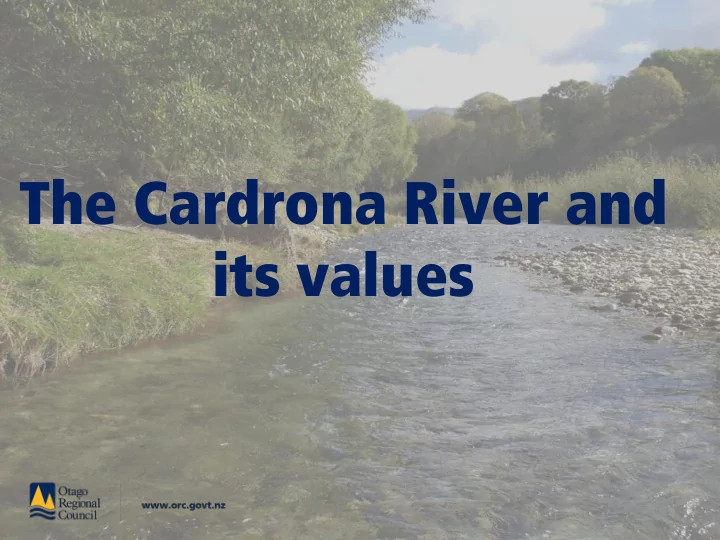

The Cardrona River and its values
Ecological values in the Cardrona Native fish • Koaro • Upland bully • Longfin eel • Clutha flathead galaxias Sports fish • Rainbow trout • Brown trout
Socio-economic values in the Cardrona • Irrigation • Aesthetics • Tourism • Recreation • 4WDing
Clutha tha flathe head ad galaxias laxias • One of the most endangered fish in NZ • Are only able to exist where trout are absent or in very low numbers • Are mainly found in small creeks and will not be affected by any minimum flow
Rainb nbow ow trout • The Cardrona and it tribs provide important spawning areas for the upper Clutha • Juvenile trout will stay in tribs for as long as possible and then be pushed downstream by floods, so minimum flows will have very little effect on them • Most adult trout leave the Cardrona by the end of November/early December
Irriga gation ion • 2,440 l/s of “paper water” allocated • Actual peak use 1,160 l/s • 620l/s above The Larches • 540 below The Larches • Total use may drop down as low as 600 l/s in dry year
Does s the Cardron ona a natur urall ally y run dry?
Hydrol ology ogy of the Cardr drona ona • Neutral reach – no net loss or gain from groundwater • Losing reach – up to 600 l/s lost to groundwater • Gaining reach – 300 l/s gained from groundwater
Points nts to keep p in mind • 400-600 l/s is lost to groundwater below The Larches • 300 l/s is gained from aquifer downstream of SH6 • If no water is taken, flows at The Larches will be approx 300 l/s more than at the Clutha confluence
Primary mary and suppleme lementary ntary alloca cation ion limits
Primary allocation limit • The default allocation “target” is 500 l/s • The current estimated actual take is 1,160 l/s • We suggest that an allocation limit of between 500 l/s and 1,000 00 l/s is established. • This will allow current water users to operate while maintaining or increasing surety of supply, but will also encourage efficient water use
Supplementary allocation • Current supplementary minimum flow is 2,860 l/s (mean flow) at the Clutha confluence • We suggest the following supplementary allocation regime Supplementary minimum flow @ Allocation block size (l/s) Clutha confluence (l/s) 1,500 500 2,000 500 2,500 500 3,000 500
Sugge ggested sted minimum mum flow option ons • 3 different minimum flow options will be suggested • Each option is designed to maintain the variety of values put forward by the community in the previous workshops
Option A “Year round flow continuity” 700 l/s all year at the Clutha confluence
Opti tion A • Provides year round flow continuity • Provides flows of approx 1,000 l/s at The Larches (optimum flow for adult and juvenile rainbow trout) • Provides year round habitat for juvenile trout in the lower reaches of the Cardrona • Run of the river irrigation will difficult in an average or dry year
Option B “Peak holiday season flow” 700 l/s May-Jan at Clutha confluence 400 l/s Feb-Apr at The Larches
Option B • May to January (700 l/s at Clutha confluence ) • Flow continuity from May to January, which includes the peak tourist season • Flows of approx 1,000 l/s at The Larches (optimum flow for rainbow trout adult, juvenile & spawning) • Allows adult trout to return to the Clutha • Moderate irrigation restriction in January
Option B • Feb to April (400 l/s at The Larches) • Allows for irrigation to occur during the driest part of the year • Does not provide flow continuity during this period • Distributes water resources between “upper” and “lower” water takes
Option C “Extended low flow” 700 l/s May-Dec at Clutha confluence 400 l/s Jan-Apr at The Larches
Option C • May to Dec (700 l/s at Clutha confluence ) • Flow continuity from May to December, which is similar to current flow regime • Flows of approx 1,000 l/s at The Larches (optimum flow for rainbow trout adult, juvenile & spawning) • Allows adult trout to return to the Clutha in Nov/Dec • Very little irrigation restriction
Option C • Jan to April (400 l/s at The Larches) • Provides status quo for current irrigation practice • Does not provide flow continuity during this period • Distributes water resources between “upper” and “lower” water takes
Effects of minimum flow options on irrigation
Recommend
More recommend